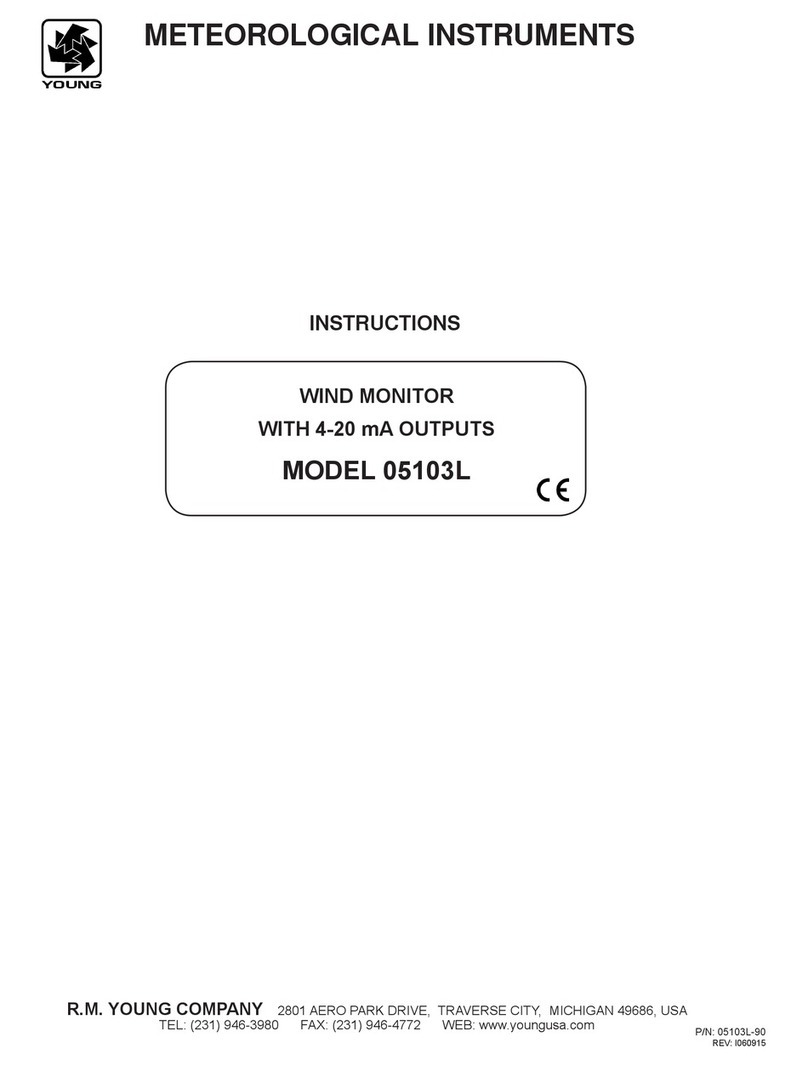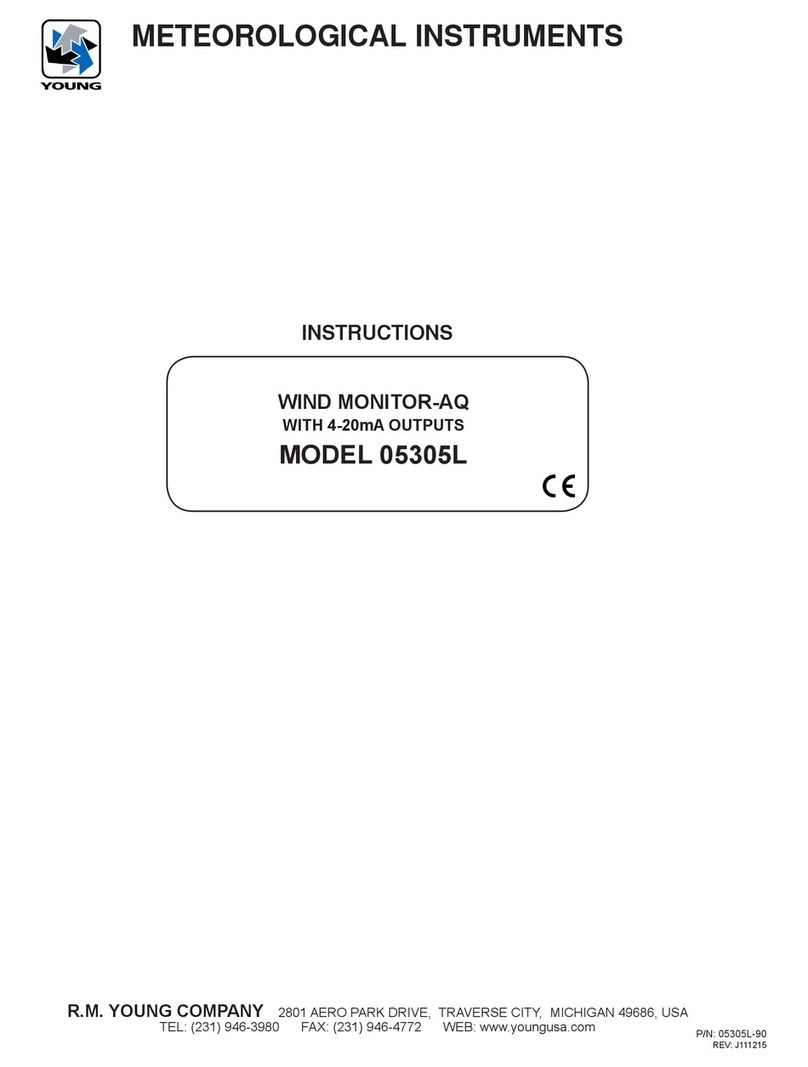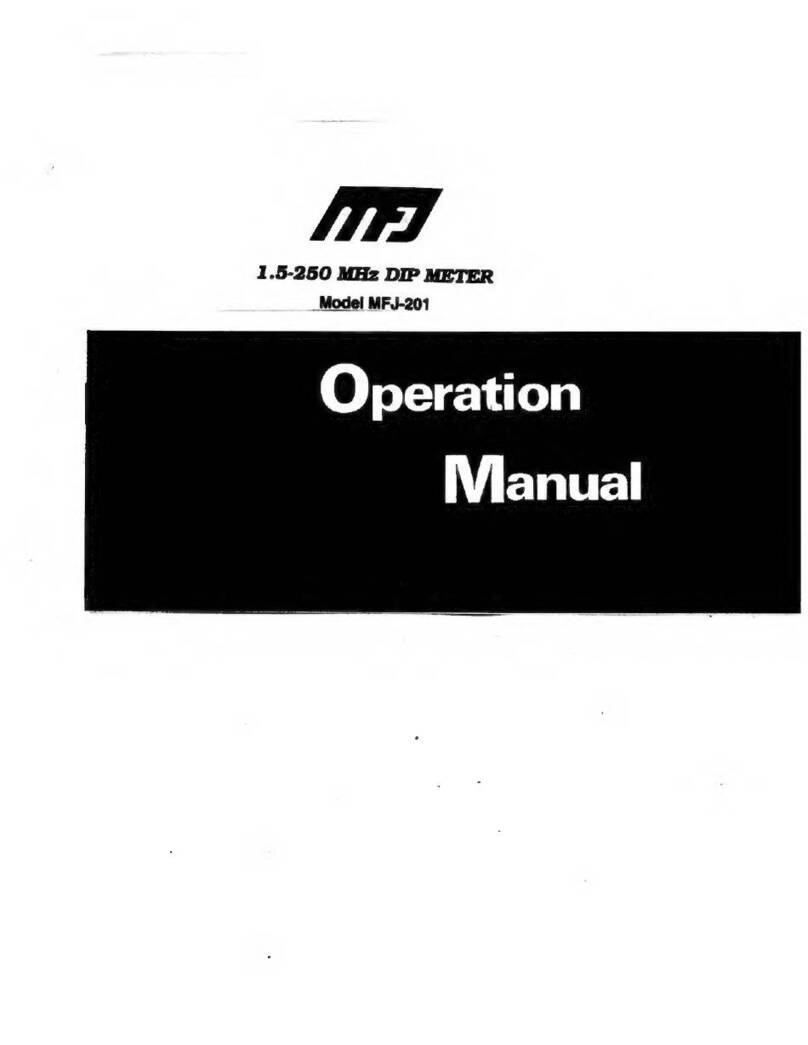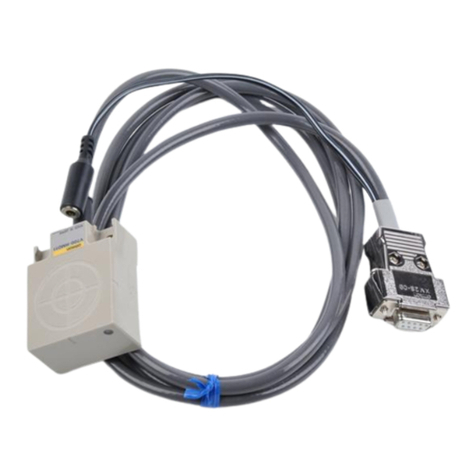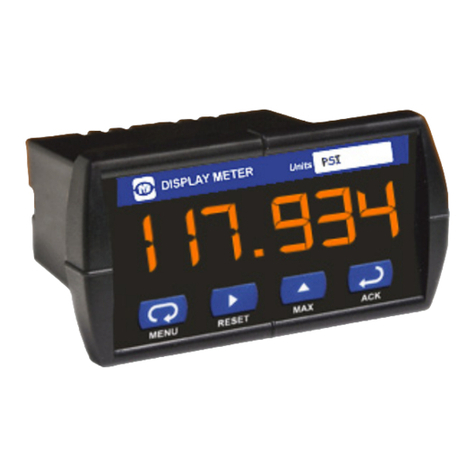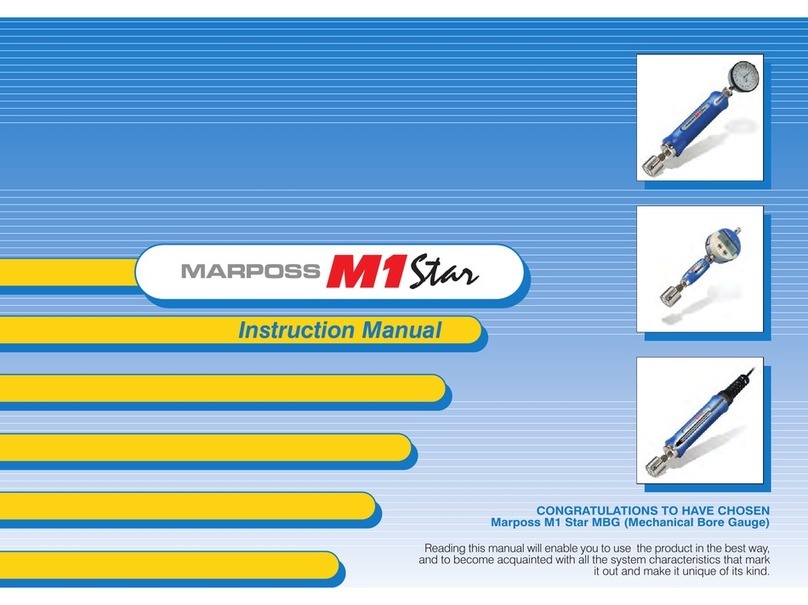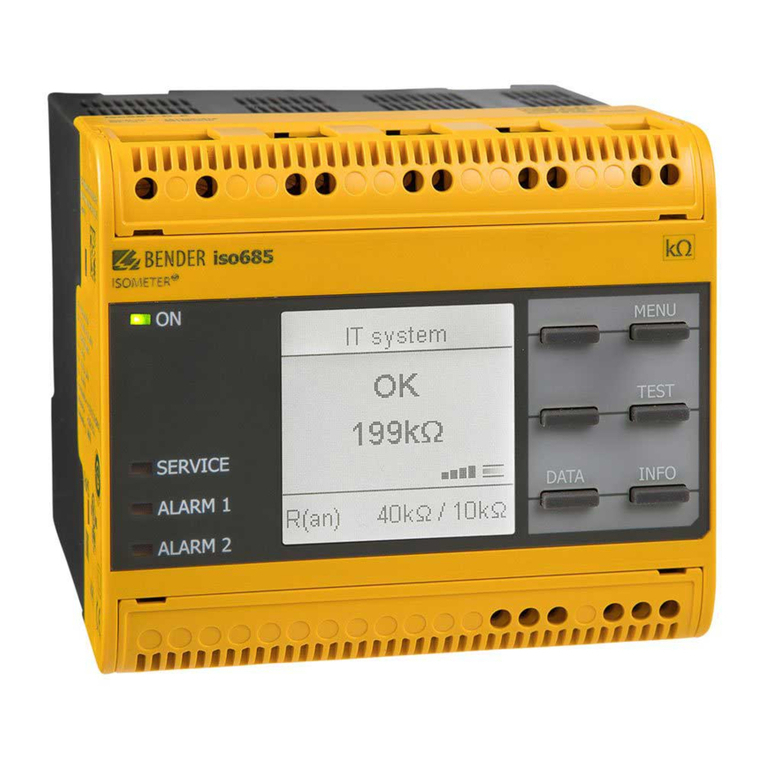R.M. Young 05305V User manual

METEOROLOGICAL INSTRUMENTS
INSTRUCTIONS
R.M. YOUNG COMPANY 2801 AERO PARK DRIVE, TRAVERSE CITY, MICHIGAN 49686, USA
TEL: (231) 946-3980 FAX: (231) 946-4772 WEB: www.youngusa.com
WIND MONITOR-AQ
MODEL 05305V
WITH VOLTAGE OUTPUTS
P/N: 05305V-90
REV: I111215

Page 1
05305V-90(I)
MODEL 05305V
WIND MONITOR - AQ
with VOLTAGE OUTPUTS
INTRODUCTION
The Wind Monitor measures horizontal wind speed and direction.
It is rugged and corrosion resistant, yet accurate and lightweight.
The housing, nose cone, propeller, and other components are
injection molded U.V. stabilized plastic. Both the propeller and
vertical shafts use stainless steel precision grade ball bearings.
Propeller rotation produces an AC sine wave signal with frequency
proportional to wind speed. Internal circuitry converts the raw
signal to a linear voltage output.
Vane position is sensed by a 10K ohm precision conductive plastic
potentiometer. This signal is also converted to voltage output.
The instrument mounts directly on standard one inch pipe, outside
diameter 34 mm (1.34"). An orientation ring is provided so the
instrument can be removed for maintenance and re-installed
without loss of wind direction reference. Both the sensor and the
orientation ring are secured to the mounting pipe by stainless steel
band clamps. Electrical connections are made in a junction box at
the base.
INITIAL CHECKOUT
When the Wind Monitor is unpacked it should be checked carefully
for any signs of shipping damage.
Remove the plastic nut on the propeller shaft. Install the propeller
on the shaft with the serial number of the propeller facing forward
(into the wind). The instrument is aligned, balanced and fully
calibrated before shipment; however, it should be checked both
mechanically and electrically before installation. The vane and
propeller should easily rotate 360° without friction. Check vane
balance by holding the instrument base so the vane surface
is horizontal. It should have near neutral torque without any
particular tendency to rotate. A slight imbalance will not degrade
performance.
INSTALLATION
Proper placement of the instrument is very important. Eddies from
trees, buildings, or other structures can greatly influence wind
speed and wind direction observations. To get meaningful data for
most applications, locate the instrument well above or upwind from
obstructions. As a general rule, the air ow around a structure is
disturbed to twice the height of the structure upwind, six times the
height downwind, and up to twice the height of the structure above
ground. For some applications it may not be practical or necessary
to meet these requirements.
FAILURE TO PROPERLY GROUND THE WIND MONITOR
MAY RESULT IN ERRONEOUS SIGNALS
OR TRANSDUCER DAMAGE.
Grounding the Wind Monitor is vitally important. Without proper
grounding, static electrical charge can build up during certain
atmospheric conditions and discharge through the transducers.
This discharge may cause erroneous signals or transducer failure.
To direct the discharge away from the transducers, the mounting
post assembly in which the transducers are mounted is made with
a special anti-static plastic. It is important that the mounting post
be connected to a good earth ground. There are two ways this
may be accomplished. First, the Wind Monitor may be mounted
on a metal pipe which is connected to earth ground. The mounting
pipe should not be painted where the Wind Monitor is mounted.
Towers or masts set in concrete should be connected to one or
more grounding rods. If it is difcult to ground the mounting post
in this manner, the following method should be used. Inside
the junction box the terminal labeled EARTH GND is internally
connected to the anti-static mounting post. This terminal should
be connected to an earth ground (Refer to wiring diagram). Initial
installation is most easily done with two people; one to adjust
the instrument position and the other to observe the indicating
device. After initial installation, the instrument can be removed
WIND SPEED SPECIFICATION SUMMARY
Range 0 to 50 m/s (112 mph)
Sensor 20 cm diameter 4-blade helicoid
carbon ber thermoplastic propeller,
30.7 cm air passage per revolution
Distance Constant 2.1 m (6.9 ft.) for 63% recovery
Threshold Sensitivity 0.4 m/s (0.9 mph)
Transducer Centrally mounted stationary coil,
2K ohm nominal DC resistance
Output Signal 50 mV per M/S
WIND DIRECTION (AZIMUTH) SPECIFICATION SUMMARY
Range 360° mechanical, 355° electrical (5° open)
Sensor Balanced vane, 48.3 cm (19 in) turning
radius.
Damping Ratio 0.45
Delay Distance 1.2 m (3.9 ft) for 50% recovery
Threshold Sensitivity 0.5 m/s (1.0 mph) at 10° displacement
Damped Natural
Wavelength 4.9 m (16.1 ft)
Undamped Natural
Wavelength 4.4 m (14.4 ft)
Transducer Precision conductive plastic potentiometer,
10K ohm resistance (±20%), 0.25%
linearity, life expectancy 50 million
revolutions, rated 1 watt at 40°C,
0 watts at 125°C
Output Signal 13.9 mV per degree
GENERAL
Power Requirement: 8 - 24 VDC (5mA @ 12 VDC)
Operating temperature: -50 to 50°C (-58 to 122°F)

Page 2
05305V-90(I)
CALIBRATION FORMULAS
Model 05305V Wind Monitor w / 08254 Propeller
WIND SPEED vs PROPELLER RPM
m/s = 0.00512 x rpm
knots = 0.00995 x rpm
mph = 0.01145 x rpm
km/h = 0.01843 x rpm
WIND SPEED vs 0-5 VDC OUTPUT
m/s = mV x 0.0200
knots = mV x 0.0389
mph = mV x 0.0447
km/h = mV x 0.0720
WIND DIRECTION vs 0-5 VDC OUTPUT
DEGREES = mV x 0.072
MAINTENANCE
Given proper care, the Wind Monitor should provide years of
service. The only components likely to need replacement due to
normal wear are the precision ball bearings and the wind direction
potentiometer. Only a qualied instrument technician should perform
the replacement. If service facilities are not available, return the
instrument to the company. Refer to the drawings to become familiar
with part names and locations. The asterisk * which appears in the
following outlines is a reminder that maximum torque on all set
screws is 80 oz-in.
POTENTIOMETER REPLACEMENT
The potentiometer has a life expectancy of fifty million revolutions.
As it becomes worn, the element may begin to produce noisy
signals or become nonlinear. When signal noise or non-linearity
becomes unacceptable, replace the potentiometer. Refer to
exploded view drawing and proceed as follows:
1. REMOVE MAIN HOUSING
a) Unscrew nose cone from main housing. Set o-ring aside
for later use.
b) Gently push main housing latch.
c) While pushing latch, lift main housing up and remove it from
vertical shaft bearing rotor.
2. UNSOLDER TRANSDUCER WIRE
a) Remove junction box cover, exposing circuit board.
b) Remove screws holding circuit board.
c) Unsolder three potentiometer wires (white, green, black), two
wind speed coil wires (red, black) and earth ground wire (red)
from board.
3. REMOVE POTENTIOMETER
a) Loosen set screw on potentiometer coupling and remove
it from potentiometer adjust thumbwheel.
b) Loosen set screw on potentiometer adjust thumbwheel and
remove it from potentiometer shaft.
c) Loosen two set screws at base of transducer assembly and
remove assembly from vertical shaft.
d) Unscrew potentiometer housing from potentiometer
mounting & coil assembly.
e) Push potentiometer out of potentiometer mounting &
coil assembly by applying firm but gentle pressure on
potentiometer shaft. Make sure that the shaft o-ring comes
out with the potentiometer. If not, then gently push it out
from the top of the coil assembly.
and returned to its mounting without realigning the vane since the
orientation ring preserves the wind direction reference. Install the
Wind Monitor following these steps:
1. MOUNT WIND MONITOR
a) Place orientation ring on mounting post.
Do Not tighten band clamp yet.
b) Place Wind Monitor on mounting post. Do Not tighten band
clamp yet.
2. CONNECT SENSOR CABLE
a) Slide junction box cover up.
b) Route cable thru strain relief opening at bottom of junction box.
Secure cable by tightening packing nut.
c) Connect sensor cable to terminals. See wiring diagram.
d) Slide junction box cover down.
3. ALIGN VANE
a) Connect instrument to an indicator.
b) Choose a known wind direction reference point on the horizon.
c) Sighting down instrument centerline, point nose cone at
reference point on horizon.
d) While holding vane in position, slowly turn base until indicator
shows proper value.
e) Tighten mounting post band clamp.
f) Engage orientation ring indexing pin in notch at instrument
base.
g) Tighten orientation ring band clamp.
CALIBRATION
The Wind Monitor is fully calibrated before shipment and should
require no adjustments. Recalibration may be necessary after
some maintenance operations. Periodic calibration checks are
desirable and may be necessary where the instrument is used in
programs which require auditing of sensor performance.
Accurate wind direction calibration requires a Model 18112 Vane
Angle Bench Stand. Begin by connecting the instrument to a signal
conditioning circuit which has some method of indicating a wind
direction value. This may be a display which shows wind direction
values in angular degrees or simply a voltmeter monitoring the
output. Orient the base so the junction box faces due south.
Visually align the vane with the crossmarkings and observe the
indicator output. If the vane position and indicator do not agree
within 5°, it may be necessary to adjust the potentiometer coupling
inside the main housing. Details for making this adjustment appear
in the MAINTENANCE, POTENTIOMETER REPLACEMENT,
outline, step 7.
It is important to note that, while the sensor mechanically rotates
through 360°, the full scale wind direction signal from the signal
conditioning occurs at 355°. The signal conditioning electronics
must be adjusted accordingly. For example, in a circuit where
0 to 5.000 VDC represents 0° to 360°, the output must be
adjusted for 4.930 VDC when the instrument is at 355°.
(355°/360° X 5.000 volts = 4.930 volts).
Wind speed calibration is determined by propeller pitch and the
output characteristics of the transducer. The calibration formula
relating propeller rpm to wind speed is shown below. Standard
accuracy is ±0.2 m/s (0.4 mph). For greater accuracy, the sensor
must be individually calibrated in comparison with a wind speed
standard. Contact the factory or your supplier to schedule a NIST
(National Institute of Standards & Technology) traceable wind
tunnel calibration in our facility.
To calibrate wind system electronics, temporarily remove the
propeller and connect an anemometer drive (18802 or equivalent)
to the propeller shaft. Apply the calibration formula to the
calibrating motor rpm and adjust the electronics for the proper
value. For example, with the propeller shaft turning at 3600 rpm,
adjust an indicator to display 18.4 m/s [3600 rpm x 0.00512 (m/s)/
rpm = 18.4 m/s].
Details on checking bearing torque, which affects wind speed and
direction threshold, appear in the following section.

Page 3
05305V-90(I)
FLANGE BEARING REPLACEMENT
If anemometer bearings become noisy or wind speed threshold
increases above an acceptable level, bearings may need
replacement. Check anemometer bearing condition using a Model
18310 Propeller Torque Disc. If needed, bearings are replaced
as follows.
1. REMOVE OLD BEARINGS
a) Unscrew nose cone. Set o-ring aside for later use.
b) Loosen set screw on magnet shaft collar and remove magnet.
c) Slide propeller shaft out of nose cone assembly.
d) Remove front bearing cap which covers front bearing.
e) Remove both front and rear bearings from nose cone
assembly. Insert edge of a pocket knife under bearing flange
and lift it out.
2. INSTALL NEW BEARINGS
a) Insert new front and rear bearings into nose cone.
b) Replace front bearing cap.
c) Carefully slide propeller shaft thru bearings.
d) Place magnet on propeller shaft allowing 0.5 mm
(0.020") clearance from rear bearing.
e) Tighten set screw* on magnet shaft collar.
f) Screw nose cone into main housing until o-ring seal is
seated. Be certain threads are properly engaged to avoid
cross-threading.
VERTICAL SHAFT BEARING REPLACEMENT
Vertical shaft bearings are much larger than the anemometer
bearings. Ordinarily, these bearings will require replacement less
frequently than anemometer bearings. Check bearing condition using
a Model 18331 Vane Torque Gauge.
Since this procedure is similar to POTENTIOMETER
REPLACEMENT, only the major steps are listed here.
1. REMOVE MAIN HOUSING
2. UNSOLDER TRANSDUCER WIRES AND REMOVE
TRANSDUCER ASSEMBLY Loosen set screws at base of
transducer assembly and remove entire assembly from vertical
shaft.
3. REMOVE VERTICAL SHAFT BEARING ROTOR by sliding it
upward off vertical shaft.
4. REMOVE OLD VERTICAL BEARINGS AND INSTALL NEW
BEARINGS. When inserting new bearings, be careful not to
apply pressure to bearing shields.
5. REPLACE VERTICAL SHAFT BEARING ROTOR.
6. REPLACE TRANSDUCER & RECONNECT WIRES
7. REPLACE MAIN HOUSING
8. ALIGN VANE
9. REPLACE NOSE CONE
*Max set screw torque 80 oz-in
4. INSTALL NEW POTENTIOMETER
a) Push new potentiometer into potentiometer mounting & coil
assembly making sure o-ring is on shaft.
b) Feed potentiometer and coil wires through hole in bottom
of potentiometer housing.
c) Screw potentiometer housing onto potentiometer mounting
& coil assembly.
d) Gently pull transducer wires through bottom of potentiometer
housing to take up any slack. Apply a small amount of
silicone sealant around hole.
e) Install transducer assembly on vertical shaft allowing
0.5 mm (0.020") clearance from vertical bearing.
Tighten set screws* at bottom of transducer assembly.
f) Place potentiometer adjust thumbwheel on potentiometer
shaft and tighten set screw*.
g) Place potentiometer coupling on potentiometer adjust
thumbwheel. Do Not tighten set screw yet.
5. RECONNECT TRANSDUCER WIRES
a) Using needle-nose pliers or a paper clip bent to form a small
hook, gently pull transducer wires through hole in junction
box.
b) Solder wires to circuit board according to wiring diagram.
Observe color code.
c) Secure circuit board in junction box using two screws
removed in step 2b. Do not overtighten.
6. REPLACE MAIN HOUSING
a) Place main housing over vertical shaft bearing rotor. Be
careful to align indexing key and channel in these two
assemblies.
b) Place main housing over vertical shaft bearing rotor until
potentiometer coupling is near top of main housing.
c) Turn potentiometer adjust thumbwheel until potentiometer
coupling is oriented to engage ridge in top of main housing.
Set screw on potentiometer coupling should be facing the
front opening.
d) With potentiometer coupling properly oriented, continue
pushing main housing onto vertical shaft bearing rotor until
main housing latch locks into position with a “click”.
7. ALIGN VANE
a) Connect excitation voltage and signal conditioning
electronics to terminal strip according to wiring diagram.
b) With mounting post held in position so junction box is facing
due south, orient vane to a known angular reference. Details
appear in CALIBRATION section.
c) Reach in through front of main housing and turn potentiometer
adjust thumbwheel until signal conditioning system indicates
proper value.
d) Tighten set screw* on potentiometer coupling.
8. REPLACE NOSE CONE
a) Screw nose cone into main housing until o-ring seal is
seated. Be certain threads are properly engaged to avoid
cross-threading.

Page 4
05305V-90(I)
EMC COMPLIANCE
This device complies with Part 15 of the FCC Rules. Operation
is subject to the following two conditions: (1) this device may not
cause harmful interference, and (2) this device must accept any
interference received, including interference that may cause
undesired operation.
This equipment has been tested and found to comply with the
limits for a Class A digital device, pursuant to part 15 of the FCC
Rules. These limits are designed to provide reasonable protection
against harmful interference when the equipment is operated in a
commercial environment. This equipment generates, uses, and
can radiate radio frequency energy and, if not installed and used
in accordance with the instruction manual, may cause harmful
interference to radio communications. Operation of this equipment
in a residential area is likely to cause harmful interference in which
case the user will be required to correct the interference at his own
expense.
This ISM device complies with Canadian ICES-001.
Cet appareil ISM est conforme à Ia norme NMB-001 du Canada.
EN55011/CISPR 11, Group 1, Class B device.
Class B equipment is suitable for use in domestic establishments
and in establishments directly connected to a low voltage power
supply network which supplies buildings used for domestic
purposes.
Note:
Wind Monitor sensors with a Voltage Interface Circuit Board may be
disrupted by radiated RF interference at 80-145 MHz. To meet EMC
Compliance, (2) YOUNG 18500 ferrite chokes must be installed
on the cable, one near the sensor, and one near the recording
instrument. (Each choke must have the cable pass through the
center hole at least 2 times, creating 1 loop around the outside as
shown below.)
WARRANTY
This product is warranted to be free of defects in materials and
construction for a period of 12 months from date of initial purchase.
Liability is limited to repair or replacement of defective item. A copy
of the warranty policy may be obtained from R. M. Young Company.
CE COMPLIANCE
This product has been tested and complies with European
CE requirements for the EMC Directive. Please note that shielded
cable must be used.

Page 5
05305V-90(I)
CABLE & WIRING DIAGRAM
MODEL 05305V WIND MONITOR-AQ

Page 6
05305V-90(I)
CIRCUIT DIAGRAM
MODEL 05305V WIND MONITOR-AQ

Page 7
05305V-90(I)
BEARING REPLACEMENT & POTENTIOMETER ADJUSTMENT

Page 8
05305V-90(I)
05194 PROPELLER NUT WRENCH
08254 PROPELLER - 20CM X 30CM (CARBON FIBER THERMOPLASTIC)
05363 FLANGE BEARING (2)
05360A NOSE CONE ASSY
05158 NOSE CONE O-RING
05161A 6-POLE MAGNET &
SHAFT COLLAR
05374
MAIN HOUSING AND
TAIL ASSY - AQ
05138A
POTENTIOMETER COUPLING
05139
POT ADJUST THUMBWHEEL
05145C POTENTIOMETER MOUNTING
& COIL ASSEMBLY
05334 POTENTIOMETER 10K
1/4% LIN, CONDUCTIVE PLASTIC
05131D POTENTIOMETER HOUSING
05330D TRANSDUCER ASSEMBLY
05324 (2)
VERTICAL SHAFT BEARING
05187 PROPELLER NUT 1/4-20
05164C PROPELLER
SHAFT W/HUB
6-32 x 1/8 SET SCREW (5)
05127 MAIN HOUSING LATCH
6-32 x 3/8 FLAT HD SCREW
05126C VERTICAL SHAFT
BEARING ROTOR
05121E-10
JUNCTION BOX COVER
05605C VOLTAGE INTERFACE
CIRCUIT BOARD ASSY
4-40 x 5/16 SCREW (3)
05121E
MOUNTING POST ASSEMBLY
05129 BAND CLAMP
(INCL. W/ 05121E, 05128B)
05128B ORIENTATION RING
05165B FRONT BEARING CAP
R. M. YOUNG COMPANY
2801 Aero Park Drive , Traverse City, Michigan 49686 U.S.A.
TEL (231) 946-3980 FAX (231) 946-4772
GENERAL ASSEMBLY & REPLACEMENT PARTS
MODEL 05305V WIND MONITOR-AQ
18500 FERRITE CHOKE (2)

Calibration Accessories
Model 18802
Anemometer Drive
Model 18112
Vane Angle Bench Stand
Model 18310
Propeller Torque Disc
Model 18331 Vane Torque Gauge
Model 18301
Vane Alignment Rod
Model 18212
Vane Angle Fixture-Tower Mount

Model 18802 Anemometer Drive provides a convenient and accurate way to rotate an anemometer shaft at
a known rate. The motor may be set to rotate clockwise or counter-clockwise at any rate between 200 and
15,000 RPM in 100 RPM increments. The LCD display is referenced to an accurate and stable quartz timebase.
For completely portable operation, the unit can be operated on internal batteries. For extended operation, an
AC wall adapter is included.
Model 18811 Anemometer Drive is identical to Model 18802 except the drive motor incorporates a
gear reducer for operation in the range of 20 to 990 RPM in 10 RPM increments. The lower range
is recommended for cup anemometer calibration.
Model 18112 Vane Angle Bench Stand is used for benchtop wind direction calibration of the Wind Monitor
family of sensors. The mounting post engages the direction orientation notch on the Wind Monitor. An easy to
read pointer indicates 0 to 360 degrees with 1/2 degree resolution.
Model 18212 Vane Angle Fixture - Tower Mount similar to the Model 18112, the tower mount feature allows use
on the tower as well as the bench top. The fixture is temporarily placed on the tower between the Wind Monitor
and its tower mounting. Index keys and notches are engaged to preserve direction reference.
Model 18310 Propeller Torque Disc checks anemometer bearing torque with 0.1 gm/cm resolu-
tion. The disc temporarily replaces the propeller for torque measurement or simple yet accurate pass/fail
checks. Charts included with the unit relate torque to propeller threshold with limits for acceptable
bearing performance.
Model 18312 Cup-Wheel Torque Disc checks cup anemometer bearing torque.
Model 18331 Vane Torque Gauge checks vane bearing torque of the Wind Monitor family sensors. Slip the
fixture over the main housing and make simple yet accurate vane torque measurements. Charts relating vane
torque to vane threshold provide limits for acceptable bearing performance.
Model 18301 Vane Alignment Rod helps align the vane of a wind sensor to a known direction reference during
installation. The base of the device has an index key that engages the direction orientation notch in the sensor
allowing the sensor to be removed without losing wind direction reference.
Specifications subject to change without notice.
YOUNG
Specifications
Ordering Information MODEL
R.M. YOUNG COMPANY
2801 Aero Park Drive
Traverse City, Michigan 49686 USA
TEL: (231) 946-3980 FAX: (231) 946-4772
E-mail: [email protected]
Web Site: www.youngusa.com
ANEMOMETER DRIVE 200 to 15,000 RPM .............................................. 18802
ANEMOMETER DRIVE 20 TO 990 RPM .................................................. 18811
230V / 50-60 HZ INPUT POWER ................................................... ADD SUFFIX “H”
VANE ANGLE BENCH STAND .......................................................... 18112
VANE ANGLE FIXTURE - TOWER MOUNT ........................................... 18212
PROPELLER TORQUE DISC............................................................ 18310
CUP-WHEEL TORQUE DISC ........................................................... 18312
VANE TORQUE GAUGE ................................................................. 18331
VANE ALIGNMENT ROD ................................................................ 18301
Copyright © 2000 R.M. Young Company, Printed in U.S.A. 11/00
Range:
200 to 15,000 RPM in 100 RPM increments
Rotation:
Clockwise or Counter-Clockwise
Display Resolution:
1 RPM
Quartz Timebase Reference:
0.1 RPM
Power Requirement:
2x9 V (alkaline or lithium) batteries
115 VAC wall adapter included
(230 VAC – add suffix H)
Range:
20 to 990 RPM in 10 RPM increments
Display Resolution:
0.1 RPM
Range:
0 to 360 degrees
Resolution:
0.5 degree
Range:
0 to 5.4 gm-cm
Resolution:
0.1 gm-cm
Range:
0 to 50 gm-cm
Resolution:
5 gm-cm
MODEL 18802 ANEMOMETER DRIVE
(Replaces 18801)
MODEL 18310, 18312 TORQUE DISC DEVICES
Calibration Accessories
MODEL 18811 ANEMOMETER DRIVE
(Replaces 18810)
MODEL 18112, 18212 VANE ANGLE
CALIBRATION DEVICES
MODEL 18331 VANE TORQUE GAUGE
Table of contents
Other R.M. Young Measuring Instrument manuals
Popular Measuring Instrument manuals by other brands
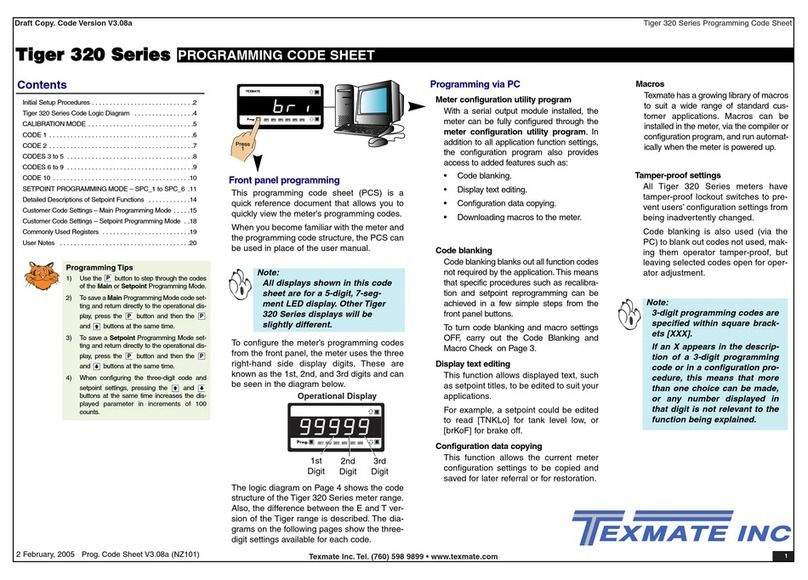
Texmate
Texmate Tiger 320 Series manual
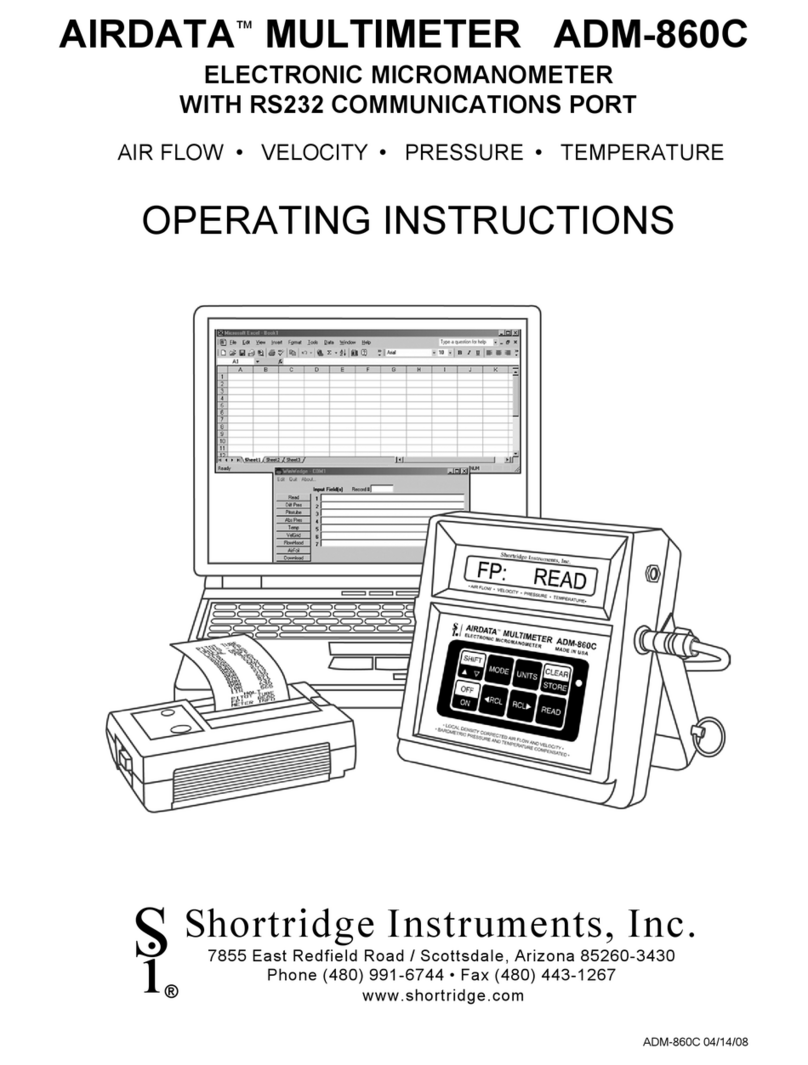
Shortridge Instruments
Shortridge Instruments ADM-860C operating instructions

Control Company
Control Company TRACEABLE 4080 instructions

IFM Electronic
IFM Electronic efector 300 SI0519 operating instructions
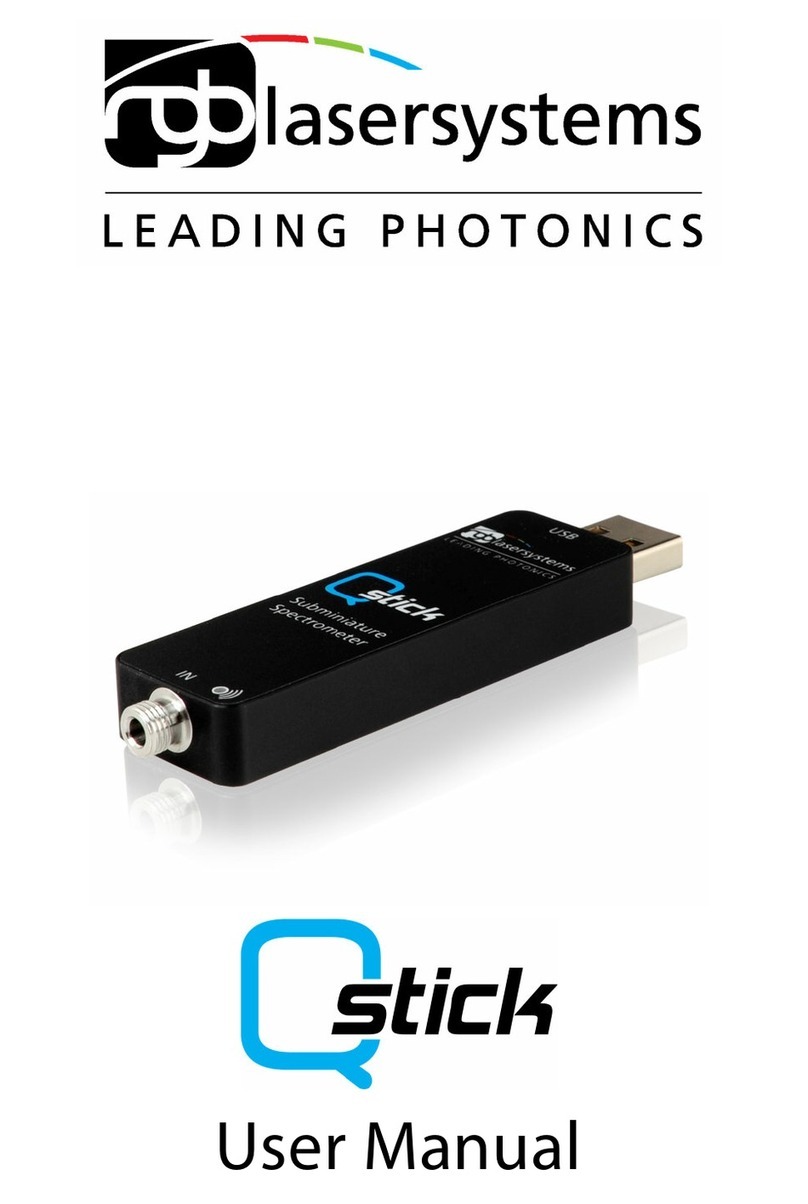
RGB Lasersystems
RGB Lasersystems q stick user manual
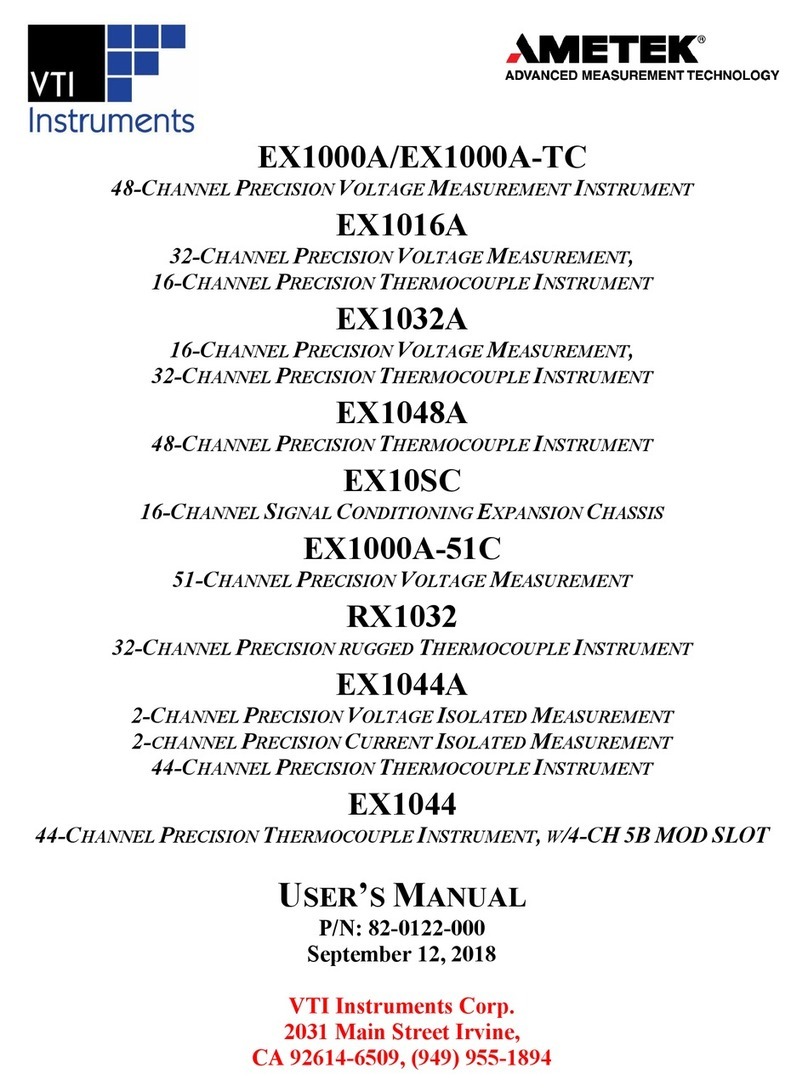
VTI Instruments
VTI Instruments AMETEK EX1044A user manual
